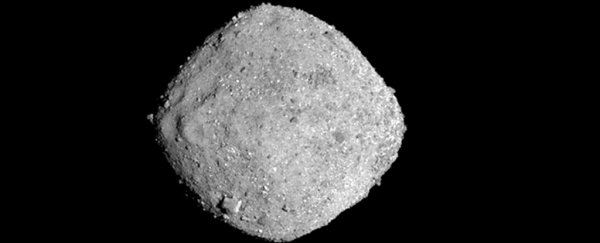For the past two years, the OSIRIS-REx spacecraft has sailed across the solar system by the light of the stars. Like ancient mariners and the Apollo astronauts, it needed the constancy of the constellations to navigate the dark unknown.
All that changed Monday, when the NASA probe finally reached its target, an Empire State Building-size asteroid called Bennu.
Now OSIRIS-REx faces a whole new kind of challenge: exploring the smallest object ever orbited by a spacecraft.
Sitting at mission control at the Denver offices of Lockheed Martin, which operates the spacecraft for NASA, engineer Javi Cerna waited for the signal indicating OSIRIS-REx had begun the burn needed to bring it close to its target.
"Standby for Bennu arrival," Cerna announced.
He fidgeted in his chair, then stood. The room was utterly silent.
Then Cerna grinned and spread his arms out wide.
"We have arrived!"
OSIRIS-REx was within 12 miles (19 kilometres) of Bennu's surface - about the distance between the White House and NASA's Goddard Space Flight Center, which manages the spacecraft.
Soon an image of the asteroid appeared on the mission control screens: a diamond-shaped body with a rough, speckled exterior. OSIRIS-REx was finally at the doorstep of its new home.
Bennu is a carbonaceous asteroid - a primitive, carbon-rich piece of debris left over from the process that formed the Solar System 4.6 billion years ago.
OSIRIS-REx will spend the next 18 months there, surveying the landscape and probing Bennu's chemical makeup before finally selecting what piece of the asteroid it wants to bring back home.
In a kiss-like maneuver, the spacecraft's robotic arm will collect material from Bennu's surface, then sling the sample back toward Earth. It will be the largest planetary sample retrieved since the Apollo era, when astronauts brought rocks back from the Moon.
Studying the sample in terrestrial labs, scientists hope to uncover clues about the birth of the planets and the origins of Earth's water and life. They may also uncover potentially useful natural resources such as organic molecules and precious metals.
And since Bennu has a 1-in-2,700 chance of impacting Earth about 200 years from now, researchers figure it would be good to glean insights about the asteroid's fate - and how it might intersect with our own.
Bennu is so small, dark and distant (about 75 million miles from Earth at the moment) that scientists could only theorize about what it might look like when they launched OSIRIS-REx two years ago.
To their delight, newly acquired close-ups of the asteroid closely match their predictions.
But there's still a lot to learn about the object, said University of Arizona Planetary Scientist Bashar Rizk, who oversees three of OSIRIS-REx's cameras.
In the coming weeks and months, his team aims to get detailed measurements of the asteroid's shape, density and gravity that will allow scientists to fine-tune how they orbit it.
Bennu is so small (about 0.05 percent of the mass of Mount Everest) that its gravity is nearly negligible. If you stood at Bennu's North Pole and jumped, you would achieve escape velocity and go soaring off into the void.
That makes orbiting - which relies on a delicate balance between a spacecraft's velocity and an object's gravity - especially hard.
"It will really be record-breaking in terms of the precision, the navigation, compared to anything we've done before," said flight navigator Coralie Adam, an engineer at aerospace company KinetX.
With gravity so weak, other factors could potentially knock OSIRIS-REx off course. Even the faint pressure of sunlight warming the spacecraft can create sufficient thrust to warp its orbit.
To counteract the influence of the sun, Adam and her colleagues will fly over Bennu's "terminator" line, where day turns to night on the asteroid's surface.
This ensures that the solar radiation pressure remains constant, so engineers can make sure they continuously counteract it.
Yet Bennu's small size also makes it possible for OSIRIS-REx to perform carefully choreographed hairpin maneuvers around the asteroid.
Engineers will uplink new orbital instructions to the spacecraft every day (a typical planetary mission might update its trajectory only once a week, Adam said). Video animations of the spacecraft's planned orbits look like an elaborate cosmic ballet.
In 2020, after 18 months of observations, OSIRIS-REx will swoop close to Bennu and extend a long robotic arm equipped with its sample-collecting instrument, called TAGSAM.
With a puff of nitrogen gas, it will blow material off the asteroid's surface, gathering as much as 4.4 pounds (2 kilograms) of rock in the head of the sample. Then it must turn around and retrace its path back home.
Finally, on September 24, 2023, a capsule containing the sample will streak through Earth's atmosphere and land in the Utah desert.
As NASA scientists learn more about Bennu, they'll be comparing their findings with counterparts from the Japanese Space Agency, whose Hayabusa 2 spacecraft arrived at the asteroid Ryugu earlier this year.
The Japanese mission was the first to land moving rovers on the surface of an asteroid, and it will return samples to Earth in 2020. Asteroid scientists are eager for "bonanza" of discoveries that await, as one researcher at mission control put it.
OSIRIS-REx scientists expect to reveal the results of their early surveys of Bennu next week at the fall meeting of the American Geophysical Union in Washington.
Asked how he was feeling at the moment of arrival, principal investigator Dante Lauretta tweeted, "relieved, proud and anxious to start exploring!"
2018 © The Washington Post
This article was originally published by The Washington Post.
